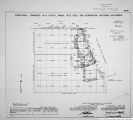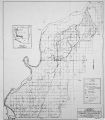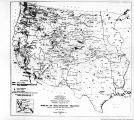| OCR Text |
Show IT0937 FORT MOJAVE AND CHEM5HUSVI RESERVATION LAND PROBLEMS The Parker Dan, constructed by the Bureau of Reclamation for the Metropolitan TTater District, Drincinally as a source oi" domestic water supply for Los Angeles and vicinity, is located 16 miles upTtrean from the Colorado River Agency. Approximately 5,000 acres of the Chemehuevi Reservation, all that la of any vr.lue, which i3 located in California between the dam and Topock, Arizona, is inundated by this development. The Indians received instructions to move out by June, 1938, While most of the Chenehuevi Tribe have moved over to the lands on the Colorado River Reservation and are recognized as members of the Colorado River Reservation tribes, there are a number who have allotments that are flooded by the Parker Dam rater. A board has aorraised the djraages caused by the flooding of this reservation, and the Chemehuevis can probably anticipate some accession to their tribal fund. The lake created by the Parker Dam also extends above Topock and inundates the lower or Bouth end of the Fort Mojave Reservation. Opinions differ as to vliat effect this lake will have on the regimen of the rivor. Should silt deposits form in the channel above the lake, thus raising tho riyer bed, seepage mi^ht take place on the balance of the Mojave Reservation and gradually change it into a marshy area. Although the llojaves norr residing on this reservation are of the same stock and same tribe as those now occupying the Colorado River Reservation, as distinguished from the Chene-huovi who originated from Nevada and who at one time were the bitter enemies of the Mojaves, they are not anxious to remove to the Colorado River Reservation area. This is true notwithstanding the fact that the chiefs of the Colorado River tribes have indicated there will be no objection interposed to their boconing members of the Colorado River Reservation tribes. Their reluctanco to abandon their homes i3 duo principally to the fact that over tho years they have earned their livelihood through employment in tho near-by town of Needles and the shops of the Sante Fe Railroad, The depression has nevertheless so restricted their employment that their migration to the Colorado River Reservation is an established economic necessity. Assuming that negotiations with the Indians of tho Colorado River Reservation, Fort Mojave and Chemehuevi Reservations looking to the consolidation of their assets and several interests are successful, there seems to be no question but that the Indians now residing on the Fort Mojavo and Chemehuevi Reservations are entitled to the use of land on the Colorado River Reservation proper. In those cases r/here Indians already have allotments either on Fort Mojave or Chomohuevi they will not bo en-titlod, under tho decisions of tho Department and the courts, to participate in tho proposed Colorado River dcvclopmont on tho same basis as unallotted Indians who are accepted for membership in the Colorado River 13 /v |
| Source |
Original book: [State of Arizona, complainant v. State of California, Palo Verde Irrigation District, Coachella Valley County Water District, Metropolitan Water District of Southern California, City of Los Angeles, California, City of San Diego, California, and County of San Diego, California, defendants, United States of America, State of Nevada, State of New Mexico, State of Utah, interveners] : |






























































































































































































































































































































